
The Grote Kerk or St.-Bavokerk is a Reformed Protestant church and former Catholic cathedral located on the central market square in the Dutch city of Haarlem. Another Haarlem church called the Cathedral of Saint Bavo now serves as the main cathedral for the Roman Catholic Diocese of Haarlem-Amsterdam.
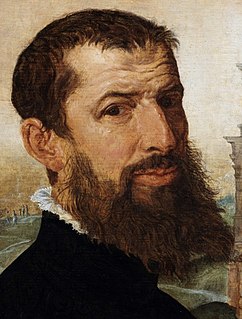
Maerten van Heemskerck or Marten Jacobsz Heemskerk van Veen was a Dutch portrait and religious painter, who spent most of his career in Haarlem. He was a pupil of Jan van Scorel, and adopted his teacher's Italian-influenced style. He spent the years 1532–6 in Italy. He produced many designs for engravers, and is especially known for his depictions of the Wonders of the World.

Karel van Mander (I) or Carel van Mander I was a Flemish painter, poet, art historian and art theoretician, who established himself in the Dutch Republic in the latter part of his life. He is mainly remembered as a biographer of Early Netherlandish painters and Northern Renaissance artists in his Schilder-boeck. As an artist and art theoretician he played a significant role in the spread and development of Northern Mannerism in the Dutch Republic.
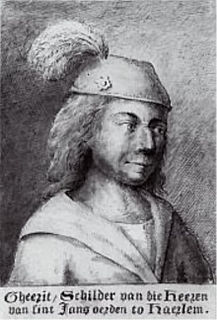
Geertgen tot Sint Jans, also known as Geertgen van Haarlem, Gerrit van Haarlem, Gerrit Gerritsz, Gheertgen, Geerrit, Gheerrit, or any other diminutive form of Gerald, was an Early Netherlandish painter from the northern Low Countries in the Holy Roman Empire. No contemporary documentation of his life has been traced, and the earliest published account of his life and work is from 1604, in Karel van Mander's Schilder-boeck.

Jan Mostaert was a Dutch Renaissance painter who is known mainly for his religious subjects and portraits. One of his most famous creations was the Landscape with an Episode from the Conquest of America.

Albert van Ouwater was one of the earliest artists of Early Netherlandish painting working in the Northern Netherlands, as opposed to Flanders in the South of the region.
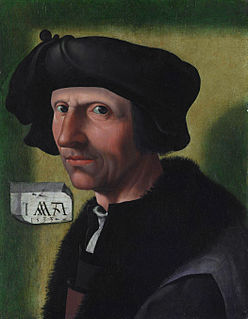
Jacob Cornelisz van Oostsanen was a Northern Netherlandish designer of woodcuts and painter. He was one of the first important artists working in Amsterdam, at a time when it was a flourishing and beautiful provincial town.

The Master of Alkmaar was a Dutch painter active around Alkmaar at the beginning of the sixteenth century. His name is derived from a series of panel paintings from the church of Saint Lawrence in that city, dated to 1504 and showing the Seven Works of Mercy; they are currently in the Rijksmuseum in Amsterdam.

The Janskerk or St. John's Church is a former church in the Dutch city of Haarlem. Today it houses the North Holland Archives.

The Haarlem Guild of Saint Luke was first a Christian, and later a city Guild for various trades falling under the patron saints Luke the Evangelist and Saint Eligius.
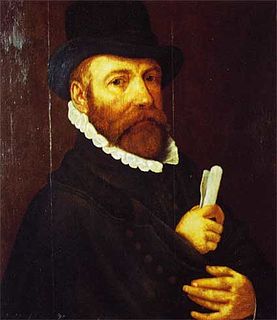
Wouter Pietersz Crabeth (1510–1590) was a Dutch Renaissance glass painter. He was employed by the Sint Janskerk (Gouda) during the Protestant Reformation, where he created six of the stained glass windows during the years 1555 to 1571. His windows, that he created in close collaboration with his brother Dirk Crabeth, are one of the reasons that the church was placed on the UNESCO list of monuments.
Albert Simonsz a distinguished historical painter, born at Haarlem in 1523, told Karel van Mander in 1604 that he had been a scholar of Jan Mostaert 60 years previously when Mostaert himself was already an old man of 70. Van Mander noted his remark because Simonsz also said that Mostaert had claimed he had never heard of Ouwater. The 18th-century writer Jacobus de Jongh was the first to extrapolate Simonsz' birth year from his statements to Karel van Mander. Simonsz clearly lived to a great age, but the exact year of his death after 1604 is not recorded. Though no known works survive, Hessel Miedema in his more recent edition of the Schilder-boeck wonders whether he isn't the same "Aelbert symonssen" mentioned in a document in the Haarlem archives who was paid 15 florins in 1592–1593 for making several copies of maps of Haarlem after the one by mayor Thomas Thomassen, and who was also paid 25 florins for making one copy of a map made in 1570 of the boundary of Rhineland after Joost Janssen of Amsterdam.
Frans Mostaert (1528–1560) was a Flemish Renaissance painter specializing in landscape paintings.
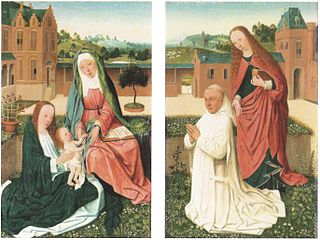
The Master of the Brunswick Diptych was a Dutch early Renaissance painter.

Master of the Figdor Deposition (1480–1500), was an Early Netherlandish painter.

Haerlempjes refer to a specific genre of landscape painting that includes a view of Haarlem. It is used most often to refer to Jacob van Ruisdael's panoramic views of the city, but the term is derived from mentions in Haarlem archives as a type of painting included in household inventories. The diminutive suffix "pje" would denote a small, cabinet-sized painting, but even the largest landscapes may be referred to as Haerlempjes today.

Saint Luke painting the Virgin is a 1532 painting by the Dutch Golden Age artist Maarten van Heemskerck in the Frans Hals Museum.

The Adoration of the Magi is a circa 1480–1485 oil on panel painting of the Adoration of the Magi by the Renaissance artist Geertgen tot Sint Jans in the collection of the Rijksmuseum.

Maria Magdalene is a circa 1530 oil on panel painting by the Dutch renaissance artist Jan van Scorel in the collection of the Rijksmuseum.

Adoration of the Magi is an oil on panel painting from the early 1520s by the Dutch Renaissance artist Jan Mostaert in the collection of the Rijksmuseum, Amsterdam, where in 2020 it was on display in room 0.1. The panel measures 51 cm × 36.5 cm, and the painted surface a little less at 48.5 cm × 34 cm. It is often called the Mostaert Amsterdam Adoration in art history, to distinguish it from the multitude of other paintings of the Adoration of the Magi.




















